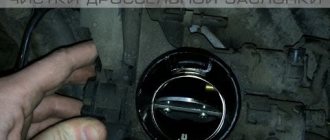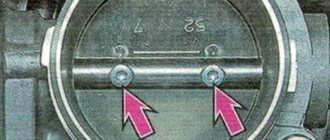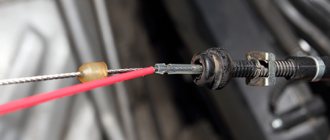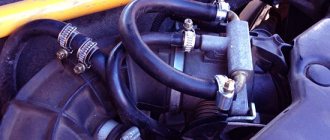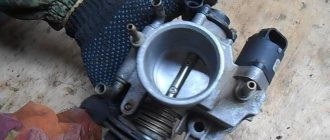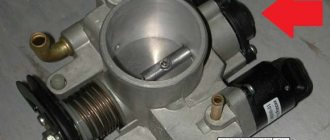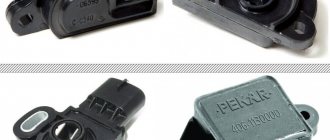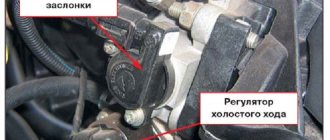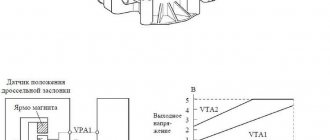March 23, 2018 Lada.Online 228 163 76
Jerking when changing gears or when starting the car. In some cases, adapting the throttle valve zero and adapting the misfire diagnostic function will help solve these problems. The adaptation process does not require special equipment and can be done with your own hands.
Throttle adaptation for Lada Granta 127 engine
And if this is not done, then what will be interesting?
Or can you do this: install the battery, but since it’s cold now, don’t do the adaptation, and when it gets warmer, remove the terminal, then put it back on and do the adaptation?
Also, is it necessary to adapt the misfire function after this?
In general, everything is somehow not right. Okay adaptation. But these are +7 degrees. Drive in emergency mode all winter?
Added after 2 minutes As I understand it, it would be best to have an old battery with you. While I took this one out for charging, I quickly installed the old one to maintain the ECU memory.
Added after 1 minute Or you can also take an unnecessary battery from the UPS - it will be easier, but enough for support.
Source
Adaptation using the example of some cars
Another method, which we will consider using the example of one well-known German brand, also involves adaptation without a computer. Here you should warm up the engine to a temperature of approximately 70-99°C. The battery voltage must be at least 12.9 Volts when the engine is not running. The action plan for how to adapt the throttle valve on a Volkswagen will be something like this:
- After warming up and turning off the engine, you should wait a short period (5-10 seconds).
- With the gas pedal released, turn on the ignition and wait 3 seconds.
- After 3 seconds, you need to press the accelerator pedal all the way 5 times and release it back. Act quickly, as you only have 5 seconds to do this.
- After the 5th exercise, you should wait a pause.
- After 7 seconds, press the pedal all the way again and hold it in this position until the “CHEK” indicator starts flashing (≈ 10 sec.), then it should remain on continuously (≈ 20 sec.).
- When the indicator lights up constantly, count to three and only then release the pedal.
- Start the engine (repeat if necessary), wait 20 seconds, then lightly accelerate (2000-3500). If the tachometer shows 700 rpm at XX (+- 50), it means that the adaptation was successful.
In this case, it is necessary to strictly adhere to the time intervals of each setting step. This is the only way the ECU training will go smoothly. But before that, it’s worth studying the adaptation features and the possibility of a manual procedure for your car. Perhaps only service station specialists can help.
Problem with idle float when starting on cold due to sticking of throttle 21127 and 21129.
Dear friends, today I’ll tell you about my experience in resolving problems with the throttle assembly. Very relevant, especially for owners of 21129 engines.
By the way, I have the firmware with the problem already fixed.
The occurrence and solution at the plant level in the case of the M74.5 ECU, it was like this. When the ignition was turned on on old versions of the ECU firmware, the micro-calibration time of the Throttle Unit (hereinafter referred to as the remote control) was, well, long, due to the fact that the owner did not wait for a 10-second pause during the ignition, this error occurred.
This problem can be fixed with firmware.
But not everyone, for example, in cars of 13-14 years, the remote control motor was of an old model, had a certain moment of jamming, then in 15 the remote control became “modernized” and this error went away altogether.
Firmware versions that have this problem:
I427DB02 I427DC03 I427DD04 I427DF04 I427DG05 I427GA01 I427GB02 I427GC03 I427GD04 I427GE05 I427GF06
Firmware versions that do not have this problem:
I427GG07 I427GKA1 I427GKA 2
Here is a photo of how to find out your firmware version, the firmware is interchangeable, at least install the oldest one on the new unit, at least the newest one.
Problem with floating XX when starting on cold
The car sits overnight, in the morning you start the revs, when it warms up, the revs begin to jump, +-300 revs, with the probability of stalling, you need to press the gas pedal lightly and everything returns to normal.
Starting the engine, the rpms are 1200, they begin to jump between 500 and 1400 and hang at 700.
Related problems:
— Jerking during a smooth start in first gear — Thoughts in part-load mode — The feeling when accelerating at 50% throttle that sometimes “as if you’re holding your ass”
How to diagnose physically: when disassembling the throttle, remove the plastic gear, twist the motor gear, if it rotates tightly or sticks, then the manual is for you.
It is necessary to remove the remote control, clean the valve (by the way, it was clean) with carburetor cleaner, then remove the cover, unscrew the motor and wash everything.
Source
When and how to do it yourself
When to do it
adaptation of the throttle valve zero and adaptation of the misfire diagnostic function:
- After replacing the ECU controller or resetting the controller using a scan tool.
- After replacing the throttle assembly.
Throttle zero adaptation procedure
:
- When the car is stationary, you must turn on the ignition, wait 30 seconds, turn off the ignition, wait until the main relay turns off.
Adaptation will be interrupted
, If:
- the engine turns over;
- the car is moving;
- the accelerator pedal is pressed;
- engine temperature is below 5 °C or above 100 °C;
- Ambient temperature is below 5 °C.
Adaptation procedure
Misfire diagnostic functions:
- warm up the engine to operating temperature (parameter value “Coolant temperature” = 60.90 °C);
- accelerate the car in 2nd gear until higher crankshaft speeds are reached (parameter value “Engine crankshaft speed” = 4000 min-1) and perform engine braking (“Engine crankshaft speed” = 1000 min-1);
- Perform engine braking six times in one trip.
This adaptation procedure is specified in the technological instructions for LADA cars.
Cleaning algorithm
Now we will give a step-by-step algorithm for properly cleaning the throttle valve.
- First of all, you need to get to the damper itself. The design is different in different engines. But as a rule, to do this you need to remove the air duct that runs from the damper to the air filter.
- Dismantle the damper. To do this, unscrew several mounting bolts (2-4 pieces), and also disconnect the necessary connectors (for example, the connector from the absorber purge valve).
- To clean, you must use a carburetor cleaner. There is a wide variety of them, and in auto stores you can easily find a product in accordance with your preferences and capabilities (we will talk about them later).
- Using a rag and the mentioned product, you must thoroughly wipe the damper outside and inside.
- You also need to clean the protective grille (if your car has one).
- Assembly of the unit is carried out in the reverse order.
Owner reviews
Owners of LADA XRAY who independently performed the throttle valve zero adaptation procedure note that the car stopped twitching and acceleration became smooth.
Some reviews from Drive2.ru (link to post):
Let us remind you that we previously published an information letter from AVTOVAZ, which tells us what to do in case of vibrations and jerks when starting off a LADA car.
Share on social networks:
Found an error? Select it and press Ctrl+Enter..
Source
see also
Throttle error
Throttle valve malfunctions
DIY throttle valve repair
Cleaning the electronic throttle valve
The task of the throttle valve (hereinafter referred to as DZ) is to regulate the amount of air supplied to the intake manifold. Its position is adjusted in accordance with the position of the accelerator pedal. The damper drive can be mechanical (using a cable) or electronic (using an electric motor). The position of the remote control is recorded by a special sensor. It transmits the relevant information to the ECU, which in turn makes a decision on the amount of fuel supplied and changing the engine operating mode. You can read more about its structure and functions in additional material on our website.
When and how to do it yourself
When to do it
adaptation of the throttle valve zero and adaptation of the misfire diagnostic function:
- After replacing the ECU controller or resetting the controller using a scan tool.
- After replacing the throttle assembly.
Throttle zero adaptation procedure
:
- When the car is stationary, you must turn on the ignition, wait 30 seconds, turn off the ignition, wait until the main relay turns off.
Adaptation will be interrupted
, If:
- the engine turns over;
- the car is moving;
- the accelerator pedal is pressed;
- engine temperature is below 5 °C or above 100 °C;
- Ambient temperature is below 5 °C.
Adaptation procedure
Misfire diagnostic functions:
- warm up the engine to operating temperature (parameter value “Coolant temperature” = 60.90 °C);
- accelerate the car in 2nd gear until higher crankshaft speeds are reached (parameter value “Engine crankshaft speed” = 4000 min-1) and perform engine braking (“Engine crankshaft speed” = 1000 min-1);
- Perform engine braking six times in one trip.
This adaptation procedure is specified in the technological instructions for LADA cars.
Self-cleansing procedure
If the damper is electronically actuated, then it is better to remove the negative terminal of the battery. Next, you can do everything according to simple instructions:
- dismantle the air filter by unscrewing the pipe clamp;
- disconnect all connectors of the throttle module and other pipes;
- move the air filter receiver to the side so that it does not interfere, and begin cleaning the damper;
- upon completion, reassemble the damper module in reverse order, checking that everything is in place;
- After assembly, start the engine and check the idle speed.
In some cases, before you begin to adapt the throttle valve on a Toyota, Nissan or Skoda, it is necessary to remove the throttle itself, which allows you to completely clean the valve. To do this, you will need a 5 mm hexagon to unscrew the 4 fasteners. Removing the throttle should be done with great care, as there is a risk of damaging the gasket.
If, after cleaning the throttle body, increased idle speed is observed, it means that the damper needs to be adapted. What this is is further in the topic of the article.
Owner reviews
Owners of LADA XRAY who independently performed the throttle valve zero adaptation procedure note that the car stopped twitching and acceleration became smooth.
Some reviews from Drive2.ru (link to post):
Let us remind you that we previously published an information letter from AVTOVAZ, which tells us what to do in case of vibrations and jerks when starting off a LADA car.
Share on social networks:
Found an error? Select it and press Ctrl+Enter..
Source
Costly mistakes when repairing a car
Unfortunately, valuable experience in quality repairs is always built on a mass of expensive mistakes. Although no one has canceled banal laziness and sloppiness.
Even ordinary machine repair operations can result in significant costs. And here the matter is not only in the attitude of the master or the owner himself to his car, but also in the mass of pitfalls of technical stones. Moreover, not all of them are mentioned even in the factory service manual.
Replacement of suspension and chassis elements
There are common cases when a client comes to the service center to replace suspension elements, and as a result, when returning the car, for some reason the ABS system malfunction lamp lights up on the instrument panel. Computer diagnostics will most likely indicate a malfunction of the wheel speed sensor, from which repair work was carried out. It’s strange, but the mechanic didn’t touch this electronic meter at all, but it has to be replaced. Where is the connection?
The most common cause of failure of the active wheel speed sensor of the ABS system is careless use of a hammer when replacing suspension elements.
The most common cause of failure of the active wheel speed sensor of the ABS system is careless use of a hammer when replacing suspension elements.
When and how to do it yourself
When to do it
adaptation of the throttle valve zero and adaptation of the misfire diagnostic function:
- After replacing the ECU controller or resetting the controller using a scan tool.
- After replacing the throttle assembly.
Throttle zero adaptation procedure
:
- When the car is stationary, you must turn on the ignition, wait 30 seconds, turn off the ignition, wait until the main relay turns off.
Adaptation will be interrupted
, If:
- the engine turns over;
- the car is moving;
- the accelerator pedal is pressed;
- engine temperature is below 5 °C or above 100 °C;
- Ambient temperature is below 5 °C.
Adaptation procedure
Misfire diagnostic functions:
- warm up the engine to operating temperature (parameter value “Coolant temperature” = 60.90 °C);
- accelerate the car in 2nd gear until higher crankshaft speeds are reached (parameter value “Engine crankshaft speed” = 4000 min-1) and perform engine braking (“Engine crankshaft speed” = 1000 min-1);
- Perform engine braking six times in one trip.
This adaptation procedure is specified in the technological instructions for LADA cars.
A few words about the car and the intake system
Since we are interested in the Priora throttle valve, we simply need to understand the engine structure of this particular model in order to find out where this part is actually located, why it needs to be cleaned and what damage can be caused by untimely maintenance. Lada Priora has been produced since 2007 in sedan, hatchback and station wagon versions.
The car went through several restylings, its appearance changed slightly, but the level of comfort, safety and quality of the Priora car noticeably improved. Today, models with automatic transmission are even available.
But no changes were made to the configuration of the equipped engines; the car is equipped with almost identical 4-cylinder engines with varying differences in the power offered: from 81 to 120 horsepower. All Prior engines are injection engines, the main difference from carburetor engines is the forced supply of fuel at certain moments directly into the engine cylinder. Our desired throttle valve also plays a significant role in this system. It migrated to the injection system from the carburetor, and, in principle, performs the same role - it meters the amount of air entering the intake manifold.
Throttle valve on Priora
On the Lada Priora engine, the valve itself is located in the throttle assembly, which in turn is located on the intake manifold. The unit is connected to the accelerator pedal drive, by pressing which the driver changes the position of the damper. The electronic intake system is a precise system for which it is necessary to take readings from certain sensors (mass air flow sensor, camshaft position sensor, crankshaft position sensor and many others). There are many of them, but we are concerned with the one that is directly related to the throttle valve. Correctly called a throttle position sensor (the abbreviation TPS is usually used), it monitors the position of the throttle and transmits data to the on-board computer so that all other elements of the power system work harmoniously.
The remote control position sensor can be either electrical or mechanical, which depends on the price of the car, although the difference between them is small.
The position sensor can also break, and when cleaning the throttle assembly, it would be useful to check it. If it becomes noticeable that the car does not switch well from high speeds to low speeds, the engine does not start well in cold weather, at low speeds the engine stalls or runs poorly - this could all be due to contamination of the throttle valve.
This is interesting: What is CVT on Toyota
Owner reviews
Owners of LADA XRAY who independently performed the throttle valve zero adaptation procedure note that the car stopped twitching and acceleration became smooth.
Some reviews from Drive2.ru (link to post):
Let us remind you that we previously published an information letter from AVTOVAZ, which tells us what to do in case of vibrations and jerks when starting off a LADA car.
Share on social networks:
Found an error? Select it and press Ctrl+Enter..
Source
Throttle adaptation for Lada Granta 127 engine
And if this is not done, then what will be interesting?
Or can you do this: install the battery, but since it’s cold now, don’t do the adaptation, and when it gets warmer, remove the terminal, then put it back on and do the adaptation?
Also, is it necessary to adapt the misfire function after this?
In general, everything is somehow not right. Okay adaptation. But these are +7 degrees. Drive in emergency mode all winter?
Added after 2 minutes As I understand it, it would be best to have an old battery with you. While I took this one out for charging, I quickly installed the old one to maintain the ECU memory.
Added after 1 minute Or you can also take an unnecessary battery from the UPS - it will be easier, but enough for support.
Source
Throttle body adaptation grant 16 valves
Throttle learning is a technical term that owners of modern vehicles have recently become familiar with. This procedure is carried out on cars equipped with an ECU (electronic control unit) in case of unstable engine idling for a number of reasons, which will be discussed below.
The first ECUs (or controllers) began to be installed back in the late 80s. In this case, the opening of the throttle angle (TA) depended on signals from the sensors and the position of the gas pedal, which changed along with the force the driver pressed the pedal.
Modern cars are equipped with electronic accelerators on which electronic sensors are installed. It is from them that data on the degree of pressure (angle) on the accelerator is read. The corresponding information is supplied to the control unit. However, remote control training is also carried out on cars equipped with gas pedals that transmit force to the throttle valve mechanically.
Most modern cars made in Europe, America and Japan have both systems installed.
Electronic gas pedal VAZ 2114: advantages of use and principle of operation
Since 2011, all cars produced by the AvtoVAZ concern are equipped with an electronic gas pedal, including VAZ 2114 models produced after 2011. The e-pedal has many advantages, but also due to the novelty of the mechanism used for AvtoVAZ, there were a number of shortcomings. Many motorists who bought a car with e-gas VAZ 2114 encountered problems after some time.
Electronic gas pedal
Signs of throttle adaptation
The throttle valve in its modern form is one of the last components to undergo electronic modernization. Instead of mechanical rods, a compact electric motor is installed on it, which serves as an actuator.
The signal to it comes directly from the throttle sensor. Together, this system allows you to control the engine correctly, supplying the required volume of fuel mixture to the combustion chambers in a timely manner. There are several signs by which you should start adjusting the throttle position.
For example, when you suddenly release the gas pedal, the engine does not go to idle and stalls; the following can also happen:
- Unstable engine operation at idle;
- a significant “freezing” of revolutions around the 1.5 thousand mark;
- drops in speed when gaining power;
- the “CHECK ENGINE” indicator lights up on the dashboard;
- difficult start at ;
- lack of response when pressing the gas pedal.
Depending on the engine type, there may be a slight loss of power, for example with engines with a V8 configuration. Also, fuel consumption almost always increases. These signs appear especially often on cars with a mileage of 30 thousand km or more, equipped with turbocharging.
What role does the air damper play in a carburetor?
The air damper is installed at the top of the carburetor and is a round or oval metal sheet. Its task is to limit or allow a large amount of air entering the carburetor. The principle of operation of the damper is approximately the same as that of the gas pedal. The only difference is that it works independently of the accelerator.
The air damper is used to facilitate starting an engine that has not been warmed up. That is, in the morning, when the engine is cold, part of the gasoline condenses and does not reach the combustion chamber. The other, remaining part is in too small an amount and is not enough to ignite. When the damper is closed, the volume of air entering the carburetor is limited and the amount of gasoline increases. Thus, the engine starts and the throttle opens to reduce fuel consumption and increase air volume.
To control the damper, both manual and automatic choke are used. Earlier cars used manual throttle control. A cable was attached to it and pulled into the cabin to the control handle. To close the damper, you need to pull the damper towards you until it stops. During the warming up process, it is gradually retracted to its original position and as soon as the engine begins to stably maintain idle speed with the throttle open, you can start driving.
The automatic “choke” has the simplest design and is a spring that controls the damper drive. Spring stretch directly depends on engine temperature. During the warming up process, the spring independently opens the damper and regulates the air supply level.
Causes
The most common reason for an adaptation to be made is the consequences of throttle valve maintenance. As a result of operation, a large amount of deposits forms in this unit, therefore, after flushing, the position of the throttle valve changes, and the ECU continues to send signals about its condition until maintenance.
Over time, natural wear occurs on the resistive layer of the sensor potentiometer and the moving elements of the throttle valve; in this case, after adaptation, it will most often require replacement. It is necessary to conduct training if changes are made to the ECU settings (chip tuning), especially if operations have been performed to increase engine power.
The procedure is performed using special programs on computer equipment or without them (a strictly defined procedure, which will be discussed below) depending on the brand of car. Auto electricians must take into account the features of the model, year of manufacture, and type of ECU installed on the vehicle.
Carburetor choke malfunctions
To ensure proper air flow to the carburetor, the choke must operate smoothly. Various choke jams can increase fuel consumption or cause many difficulties when starting a cold engine.
Jamming of the damper most often occurs due to improper operation of the return mechanism, when after closing the damper, it does not return to its original position. In addition, malfunction of the damper axis and lever also leads to disruption of its operation. In this case, it is necessary to carefully check the operation of the damper under the hood of the car and eliminate any faults found.
The second malfunction of the damper is hidden behind damage to the cable. More often than not, it breaks, as a result of which the air damper does not react in any way to changes in the position of the handle. In this case, the cable must be replaced with a new one.
Other troubles that could happen to the cable include stretching. The damper also does not respond to movements of the handle. There is a special cable clamp at the place where the choke lever is attached. The latter is inserted into this clamp and pressed with a bolt. It should be relaxed and using pliers, pull the cable to the required level. To make the task easier, you need to pull the damper towards you, close the damper and fix the cable in the resulting position. After carrying out all these operations, it is necessary to check the operation of the damper, and if any adjustments are necessary, they should be made in the same way.
As for the automatic control of the air damper, everything is much simpler. The fact is that its operation, as mentioned earlier, is based on a special spring. Most often, it is this that fails, so it should be replaced immediately.
Just as with other types of control, it is necessary to check the operation of the lever and the damper axis.
Unlike manual control, driving with a faulty automatic damper is the least economical. The fact is that a manual drive can be adjusted independently under the hood, but an automatic drive cannot always be adjusted. It depends on the design features. That is why it is necessary to begin repairing the damper as soon as possible.
That's all you need to know about the carburetor choke. As you can see, this unit is quite simple and absolutely easy to repair, so any car enthusiast can handle it.
Need for maintenance
The prophylaxis procedure should not be carried out in the absence of obvious reasons. Before starting, you need to carefully evaluate the condition of the throttle valve. If there are no obvious signs of tar deposits and areas of coking, then the reason for unstable operation may lie elsewhere.
Also consider the mileage of the car. Experts recommend resorting to flushing no earlier than after 100 thousand km. But on some cars, for example, a Ford Focus, it may be necessary to flush it after 30 thousand kilometers.
You should know how to clean your throttle body to achieve the desired result. This requires a special carburetor cleaning solution, for example, Abro Carb & Choke Cleaner or similar products. The assembly must be dismantled; only in this case can the maximum effect be achieved, otherwise carbon deposits will remain inside the tubes. Disconnect all pipes from the throttle valve to gain good access to the inlet part of the assembly.
Remove carbon deposits delicately using a clean rag or soft brush. Do not use excessive force; you may damage the valve. The internal elements are coated with a thin layer of molybdenum, which novice car enthusiasts mistake for harmful deposits.
Throttle learning idle
After flushing the unit or reflashing the ECU, the throttle valve should be trained to idle. To do this, fulfill the following conditions:
- check the voltage on the battery with the engine off, it should be at least 12.9 V;
- the coolant temperature should be in the range from 70 to 100 degrees;
- the steering wheel must be in a neutral position;
- The gearbox oil must be warmed up;
- all electrical consumers are turned off;
- automatic transmission handle in position P.
Failure to comply with the above requirements will lead to incorrect operation of the engine, so they must be followed. After warming up the engine, you must:
- turn off the ignition for 10 seconds;
- make sure that the accelerator pedal is in the up position;
- turn the key to the ON position for 3 seconds (do not start the engine);
- Press the gas pedal all the way 5 times within 5 seconds and release it for the last time;
- after 7 seconds, press the gas pedal all the way and wait until the “CHESK ENGINE” display lights up continuously;
- After pausing for 3 seconds, release the gas pedal.
Try to start the car, the attempt can be repeated several times. During stable operation, rev the throttle several times and the idle speed should return to the acceptable range.
The procedure for learning the throttle using a PC and car programs has its own specifics, depending on the brand of car, etc. Therefore, it makes no sense to describe the entire process in detail. But first you need to install special software on your PC, for example, VAG-COM for a VAG car group (or other) and drivers. The following is the standard connection order for all:
- turning on the ignition;
- connecting the PC to the car diagnostic connector with an information wire;
- launching software on a PC;
- conducting a test;
- receiving information about readiness for further work - the inscription: “The adapter is ready for work.”
Following a special algorithm, you will be able to coordinate the remote control and the ECU in the “throttle fully open/fully closed” modes for cars with both an electronic and mechanical gas pedal. In this case, the throttle valve training is carried out when the car is warm and the above requirements are met.
- Features of the Lada Granta throttle assembly
- Electronic gas pedal Lada Granta
- Malfunctions of the electronic gas pedal
- Cleaning the electronic throttle valve E-Gas Lada Granta 16V
Features of the Lada Granta throttle assembly
The throttle valve is turned by an electric motor through a gearbox. Both are built into the throttle body. When starting and warming up the engine, as well as during idling, the flow of air into the cylinders is regulated by opening the throttle valve. The throttle position is controlled by two sensors built into the throttle body.
The throttle valve opening angle is set by the electronic control unit (ECU) depending on the estimated amount of air that should enter the engine cylinders. This takes into account the operating mode of the engine (starting, warming up, idling, and so on), the temperature of the ambient air and the engine, and the position of the gas pedal.
Control commands are sent to the throttle assembly to the electric motor. At the same time, the ECU monitors the opening angle of the damper and, if necessary, sends appropriate commands to adjust its position. As a result of the fact that the ECU simultaneously regulates the amount of injected fuel and incoming air, the optimal composition of the combustible mixture is maintained in any engine operating mode.
The electric throttle body is sensitive to deposits that may accumulate on its inner surface. The resulting layer of deposits can interfere with the smooth movement of the throttle valve, jamming it (especially at low opening angles). As a result, the engine will operate unstably and even stall at idle, start poorly, and failures may also appear during transient conditions. To avoid this, as a preventive measure, deposits should be removed with special detergent compounds during regular vehicle maintenance. A large layer of deposits can completely block the movement of the damper. If flushing fails to restore the throttle assembly to operability, it must be replaced.
A malfunction or incorrect operation of the throttle assembly may be caused by a broken contact in its electrical circuit (oxidized terminals in the wiring harness connection block). In this case, it will be possible to restore operation by treating the terminals with a special compound for cleaning and protecting electrical contacts. There are other possible causes of the malfunction:
— no supply voltage is supplied to the throttle assembly;
— signals are not received from both throttle position sensors;
— The computer cannot recognize signals from the throttle position sensors.
In these cases, the engine control system goes into emergency mode. At the same time, the car retains the ability to independently move a short distance at a slow speed, which, in extreme cases, will allow it to be moved to a safe place
(move to the side of the road, leave the intersection, etc.).
The fact that the throttle assembly is operating in emergency mode may be indicated by a burning indicator lamp for a malfunction of the engine management system and an increased speed of the crankshaft at idle (about 1500 rpm, despite the fact that the engine is warmed up to operating temperature), the engine at this will not respond to pressing the gas pedal.
Each of the throttle position sensors is a potentiometer. During operation, gradual wear of conductive paths and moving contacts occurs. Over time, wear can reach such an extent that the sensor cannot function correctly. The presence of two sensors increases the reliability of the entire unit.
If only one sensor fails, the warning lamp will light up, but the engine management system will switch to backup mode. In this case, the engine will respond adequately to pressing the gas pedal, but with worse performance parameters
The reserve mode allows you to drive your car to the repair site under your own power.
Electronic gas pedal Lada Granta
On modern cars, instead of the usual cable drive for throttle control, a so-called “electronic gas pedal” is installed. In such cars, the throttle position is controlled electronically. When you press or release the gas pedal, information about this goes to the control unit (ECU) and only after processing and adjustment is a command given to the throttle module. The pros and cons of such a system, as well as signs of malfunctions, will be discussed in this article.
For those who are accustomed to mechanical drives, where pressing the gas pedal directly causes the throttle to move, driving a car with an electronic system will be unusual and unknown. To understand, you need to understand the principle of operation of the “electronic pedal” and its difference from a conventional mechanical one.
Getting rid of engine vibration part 2. Throttle revision
1 Cleaning and lubricating the throttle
Recently, the car has become very annoying with the behavior of the throttle. The car reacted nervously and with a slight delay to pedal presses, the idle speed fluctuated greatly, and releasing the gas was like a blow. I went for spring diagnostics for 299 rubles. Everything is fine, no electrical problems. I checked the spark plugs and changed the fuel. There was no effect, I tried to remove and clean the throttle, but knowing AvtoVAZ I decided to look at the condition of the E gas reducer. I bought a throttle cleaner and got to work. When I unscrewed the throttle nuts, the studs came out with them. The studs are held inside the plastic manifold by nuts; they fell out. I had to look for new ones and use thread glue. The damper was crap quite badly, especially around the axis of rotation. I slightly lifted the flap and turned it; it moved with little effort and stuck. A view opened up to the end of the damper; there was a lot of carbon deposits on it, which interfered with the passage of air at idle. Hence the sausages at low speeds. I washed everything, blew it with a cleaner from the heart. The biggest surprise was waiting inside the gearbox. We open it and see a completely dry gearbox. Not a drop of grease on the gears. The idler gear shaft has wear and plastic dust from the gear. And there’s actually an oval hole in the lid! I blew it out and lubricated it, very little lubrication is needed. A little inside the idler gear, a little into the cover and onto the drive gear of the engine. We close everything and put it in place. The result is excellent. Before cleaning and inspection: — Starting the engine was accompanied by vibration and floating speed. — Idle speed fluctuated greatly from 830 to 950 revolutions, sharply and with dips. — Acceleration up to 2500 rpm was sluggish, after 2500 it was like a kick. The car accelerated faster. — The release of gas was accompanied by a strong nod, which created discomfort in the flow. — The overall reaction to the gas pedal was very sluggish. — Squeaking sound when the ignition is turned on. After cleaning and inspection: - Now the engine starts, somehow abruptly, the speed is stable, vibrations are minimal - Idle speed has become more even, floating within 860 - 900 revolutions. — Acceleration is now smooth throughout. There is no such jerk after 2500. — The throttle release is smooth, the needle falls smoothly
